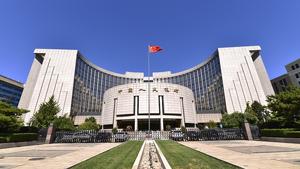 Headquarters of the People's Bank of China (PBOC), the central bank, is pictured in Beijing, Sept 28, 2018. (Photo / VCG)
Headquarters of the People's Bank of China (PBOC), the central bank, is pictured in Beijing, Sept 28, 2018. (Photo / VCG)
BEIJING — China's one-year loan prime rate (LPR), a market-based benchmark lending rate, came in at 4.05 percent Friday, unchanged from the previous monthly adjustment, as the country's flexible and prudent monetary policy creates enough leeway for lenders to better support an economy hit by the novel coronavirus disease (COVID-19) outbreak.
The over-five-year LPR, on which many lenders base their mortgage rates, also stayed unchanged at the previous reading of 4.75 percent, according to the National Interbank Funding Center.
Based on the quotes made by quoting banks by adding a few basis points to the interest rate of open-market operations (mainly referring to the rate of the medium-term lending facility, or MLF), the LPR is calculated by the center, serving as the pricing reference for bank lending.
As the People's Bank of China, the central bank, did not lower the MLF rate after cutting the targeted reserve requirement ratio (RRR), the unchanged LPR was in line with expectations in a financial market that is waking up to more easing streaks overseas
ALSO READ: LPR reform confirms domestic orientation of monetary policy
As the People's Bank of China (PBOC), the central bank, did not lower the MLF rate after cutting the targeted reserve requirement ratio (RRR), the unchanged LPR was in line with expectations in a financial market that is waking up to more easing streaks overseas.
Central banks worldwide are in the thick of bold monetary easing measures to calm pandemic jitters and shore up economies. Given this backdrop, analysts say the unchanged LPR and previous liquidity operations in China pointed to a monetary policy that is taking things in stride and reserving room for future adjustments.
Yang Changxiao, an economist with brokerage firm Zhongtai Securities, attributed the consistent LPR to the absence of obvious liquidity tightening in the market and the fact that conditions at home do not justify a rush for monetary policy adjustment.
No new domestically transmitted cases of COVID-19 were reported on the Chinese mainland Thursday, according to the Chinese health authority Friday.
With the disease further contained, inflation expectation and social demand have picked up, putting further easing moves on the back burner, said Ying Xiwen, a senior researcher with China Minsheng Bank.
"In contrast, as the disease situation worsens in Europe and the United States, we are seeing what we call a 'liquidity trap' and rising deflation expectations," Ying said, referring to an economic situation where the central bank cannot use expansionary monetary policy to boost economic growth as people hoard financial capital instead of investing or spending.
The PBOC has reiterated its commitment to issuing prudent monetary policy and vowed against adopting flood-like stimulus in its efforts to expedite recovery in the world's second-largest economy. Its earlier targeted liquidity-boosting measures to shore up the real economy are already yielding positive results.
The PBOC has expanded a special re-lending quota by 500 billion yuan (about US$70.4 billion) from the original 300 billion yuan and cut RRR by between 50 to 100 basis points for eligible banks starting Monday.
Financial boosts like strengthening credit support and maintaining sufficient market liquidity can free up more funds for companies in need and a lower interbank borrowing rate, cushioning the real economy against the COVID-19 impact, said Cui Li, a chief economist with investment services provider CCB International.
Official data showed 111.4 billion yuan worth of loans from the 500-billion-yuan re-lending and re-discount quota has been issued to support virus-hit businesses like spring farming, animal husbandry and foreign trade, while 182.1 billion yuan from the 300-billion-yuan fund has been issued to 4,708 key companies at an actual interest rate of 1.28 percent, lower than the 1.6-percent cap ordered by the State Council.
As greater credit support is trickling down the financial market, China's new yuan-denominated loans totaled 4.24 trillion yuan during the first two months of the year, up 130.8 billion yuan year on year, while corporate bonds and non-financial stocks have also seen upticks in the sum raised during the same period.
READ MORE: China's loan prime rate falls to 4.25% under new mechanism
While the international financial market is undergoing heightened volatility, the relative calm of China's A-shares showcased the country's economic resilience and the upbeat global sentiment toward its high-quality growth, said Cui.
Major Chinese benchmarks closed higher on Friday, with the Shanghai Composite Index up 1.61 percent to 2,745.62 points, and the Shenzhen Component Index 1.3 percent higher at 10,150.13 points.
The PBOC said it will continue to take multi-pronged measures to lower loan interest rates and help companies resume production in the near future, while research by an institute with the Bank of Communications saw the possibility of the LPR dropping by 15 to 30 basis points within the year.
With the ongoing LPR reform to further extend the effect of lower interest rates to companies, China still has enough monetary policy ammunition to bolster the real economy, Cui said.


